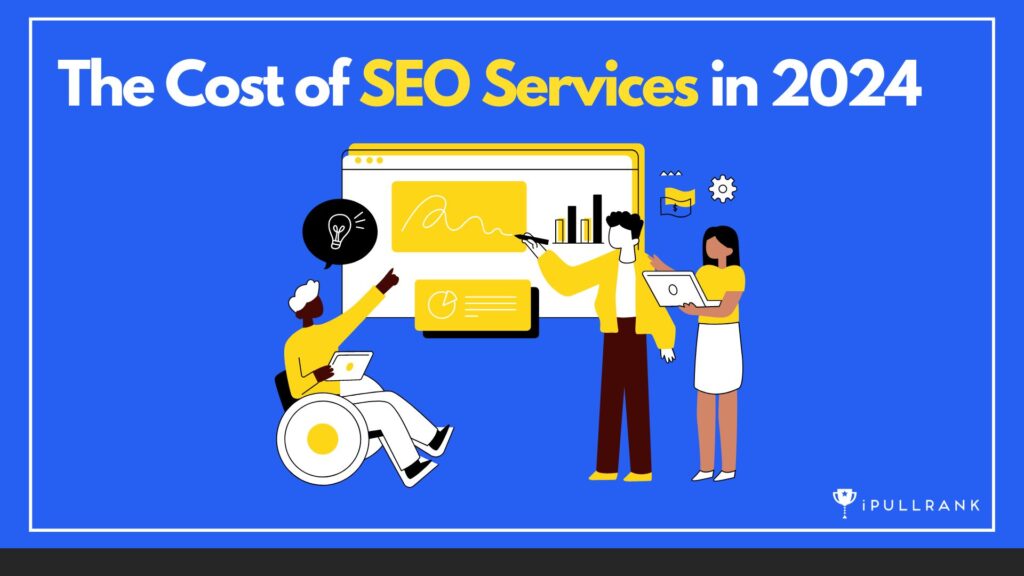What should SEO cost?
Clients don’t have a standard model they can refer to. There’s no governing body that determines what SEO should cost. All we have are educated guesses about what things may cost, right?
Not true.
Believe it or not, we have a lot of data to work with when it comes to cost. It’s true, there’s no governing body that outlines the cost of SEO services. But it’s absolutely false that we don’t know what SEO should cost.
Today we’ll lay it all out for you.
Why the cost of SEO is important
It boils down to two words: keyword difficulty.
I know you know what keyword difficulty means, but the executives you’re pitching in the C-suite may not. So let’s provide them with a definition so we’re all on the same page.
According to Ahrefs, “Keyword Difficulty (KD) is an SEO metric that estimates how hard it would be to rank on the first page of Google for a given keyword. It is measured on a scale from 0 to 100, with the latter being the hardest to rank for.”
Note: Keyword difficulty is a metric that’s designed by SEO software companies, it’s not an end-all-be-all metric. Each SaaS tool has their own version of it. If you’re going to rely on keyword difficulty as a metric, do what you can to verify things in your own campaigns.

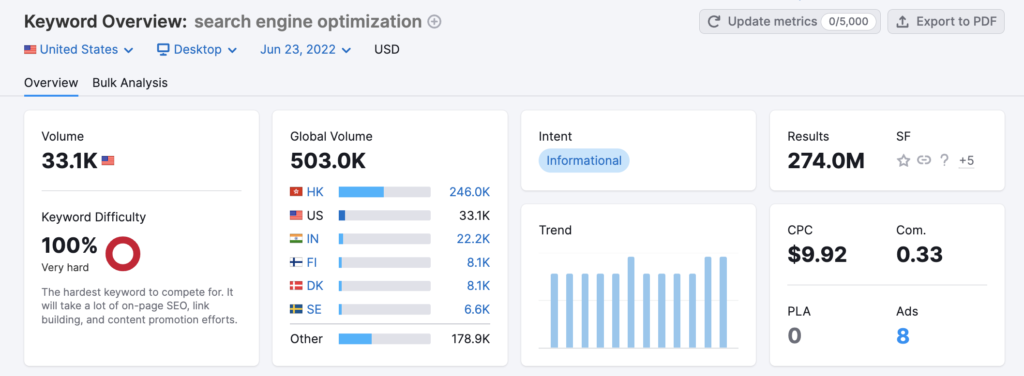
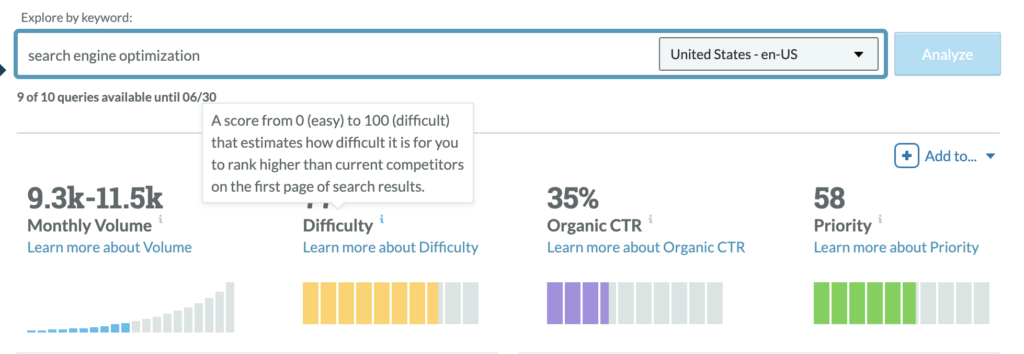
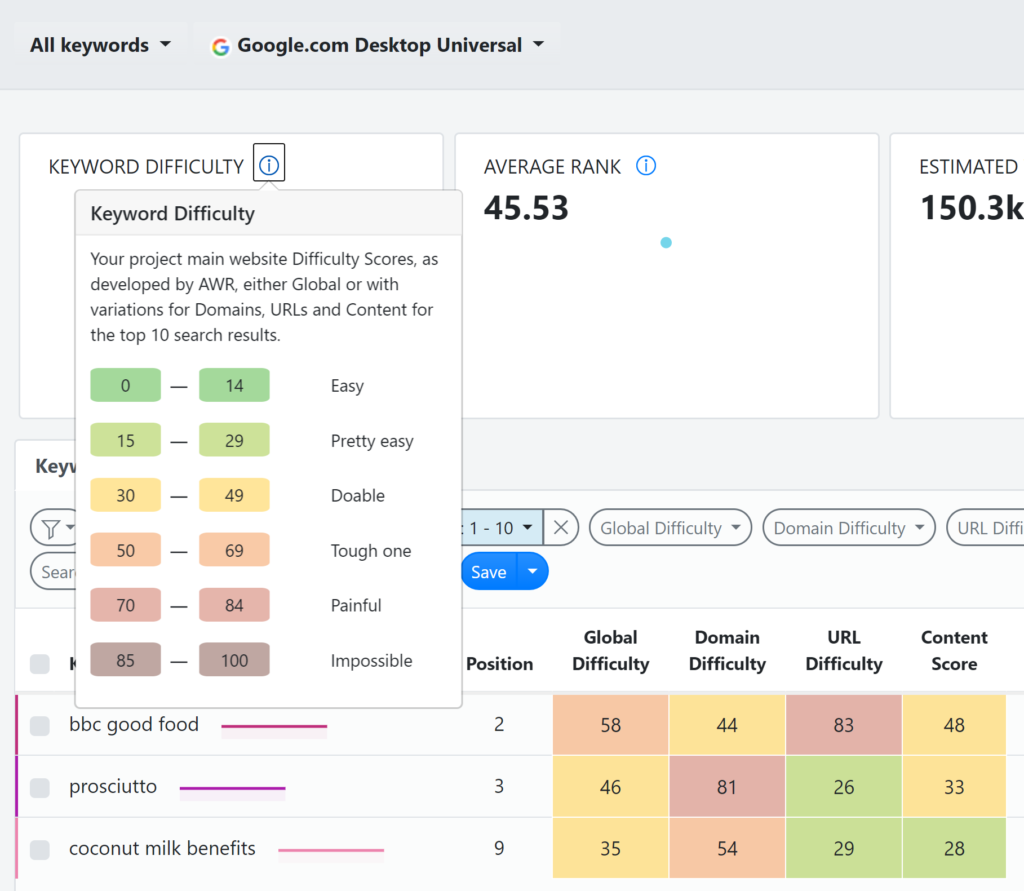
What does keyword difficulty have to do with the cost of search?
Quite a lot.
With SEO, you want to fight battles you can win. It doesn’t make financial sense to fight for keywords, rankings, visibility, etc. if you’re not reasonably confident you can achieve the results you’ve set out to achieve.
It’s dangerous.
If you’re leading the charge with SEO and you’d like to keep your job, you have to:
- Choose keywords that will (eventually) lead to traffic and revenue.
- Create content that will produce audience conversions (e.g., opt-ins, follows, sales).
- Optimize your content so it’s visible in Google’s search results.
- Grow traffic to your content pieces using on-page (internal linking) and off-page (link building) tactics.
- Update content so traffic and rankings are preserved.
Succeed, and you’ll be rewarded by management. Fail, and you may experience budget cuts, layoffs, or a loss of key team members.
Keyword competitiveness is a guide
SEO is a zero-sum game. You’re looking to unseat a competitor (or few) and take their place in Google’s search results. Keyword difficulty is an SEOs way of asking, “Is this a fight we can win?”
What does this mean?
You’re looking at the following factors:
- The overall cost of your keywords (vs. your breakeven cost per click)
- The performance of these keywords (e.g., impressions, CTR, conversions)
- Cost per Conversion, how much these keywords are worth
- Your Return on Ad Spend (ROAS)
This is crucial.
The more competitive the keywords, the more expensive your SEO campaigns are; in order for you to win, someone else must lose (visibility, rankings, traffic, etc.).
This applies throughout the buyer’s journey.
It’s important that you rank for queries at all levels of the buyer’s journey — awareness, consideration, and decision keywords. These keywords are going to have varying levels of competition and different financial values. If you rank for:
- Awareness keywords you get the chance to educate customers first, earn opt-ins, and warm customers up for paid advertising. These keywords are all about building familiarity, providing education, and conveying information at the appropriate time.
- Consideration keywords give you the opportunity to defuse objections, address risks, and demonstrate why your product or service is a better fit than your competitors. These keywords are typically more expensive than awareness keywords but less expensive than decision keywords.
- Decision keywords are typically more expensive than awareness and consideration keywords because customers at this stage are active buyers. That could be profitable if you’re able to close the sale, but it could also be an expensive mistake if you haven’t had the chance to educate, prime, or assist customers as they move through your funnel.
This is why it’s so important to rank for all three keyword types.
But wait, there’s more.
Some industries or verticals (banking, mortgages, real estate, insurance) are automatically more expensive due to tremendous competition — these industries are high value and very profitable. Your keywords give you an indicator of the fight ahead of you.
The more informed you are, the more accurate your cost estimation will be.
The factors that influence SEO pricing
Your SEO campaigns will probably include some or all of the following:
- Outlining your SEO strategy: Which channels will you lean on (e.g., content marketing, local search, link building, internal linking, and technical SEO)? How will you plan on generating traffic and revenue from your keyword list? Which keywords will generate cash flow?
- Conducting technical and nontechnical audits: Benchmarking your website’s performance across a variety of factors — indexation, rankings, conversions, revenue, backlinks, historical performance over time, etc. This starting point is an important step that’s used later to determine the objective success or failure of the campaign. These audits also include regular reporting to discuss the results achieved throughout the campaign.
- Defining your audience: Your audience includes prospects, customers, competitors, serial linkers, casual readers, and detractors. You’ll need a plan that accounts for each of these groups; content that attracts subscribers and buyers repels detractors, addresses competitors, and caters to the large and small influencers.
- Using paid search data: This could be as simple as using query reports, analytics, and conversion data from paid search campaigns or as involved as running a paid search campaign and using the data to establish confirmed conversion keywords. This data is actionable because it shows you which keywords lead to revenue.
- Content engineering: You’re reverse-engineering the heuristics and details that Google wants to see. This means you’re approaching content development with a comprehensive point of view. Content engineering is an approach that gives everyone on your team a clear, data-driven plan of action to follow. They’ll know who they’re speaking to and what they want.
- Creating content that’s optimized for search: SEO content isn’t a thing. The focus instead is on creating content that’s a fit for the audience segments you’re targeting and verifying that Google knows that. The content is organized around topic clusters, feeding Google the content it wants.
- Ongoing content equity rebalancing: This is the process of realigning the search equity of digital content assets (website URLs). This process allows you to realign or redistribute the value of underperforming pages by updating, improving, or removing existing content. This hardens your content portfolio, ensuring it survives content decay (the consistent and inevitable decline in organic traffic, rankings, and visibility).
- Managing review and social media accounts: You’re driving traffic to your content from your social media posts. You’re using your review portfolio to improve local search performance. You’re using both profile types to increase audience engagement and referrals.
- On-page and technical optimization includes factors like your page, site, or navigation architecture. You’re improving your site via on-page optimization, technical improvements, internal linking, usability, or other on-site factors.
- Ongoing off-page optimization: This broad category includes local search, reviews, social media, internal linking, link building, PR, apps, domain acquisitions, and more. This portion of the campaign is heavily dependent on the SEO strategy created at the start of the campaign.
The bigger your budget, the more resources available to focus on each factor.
Here’s why this matters.
At the lower end of the price spectrum, SEOs charge $500 per mo. (or less) for their services. At that price point, there simply isn’t enough budget to take care of the items above.
Well, how much should SEO services cost?
What a profitable SEO campaign should cost
Ahrefs surveyed agencies, asking them how much they charge for their SEO services and the pricing models they used.
First, some important takeaways from their survey.
- 34.8% bill by the hour, 78.2% use retainers, 48.9% charge a per-project fee
- Most agencies and professionals rely on a monthly retainer.
- Most rely on the retainer model. Only 40.8% offered alternative payment models.
- $500 – $1,000 per month and $2,500 – $5,000 per month were the most common pricing tiers.
- Agencies charge more than freelancers (obviously).
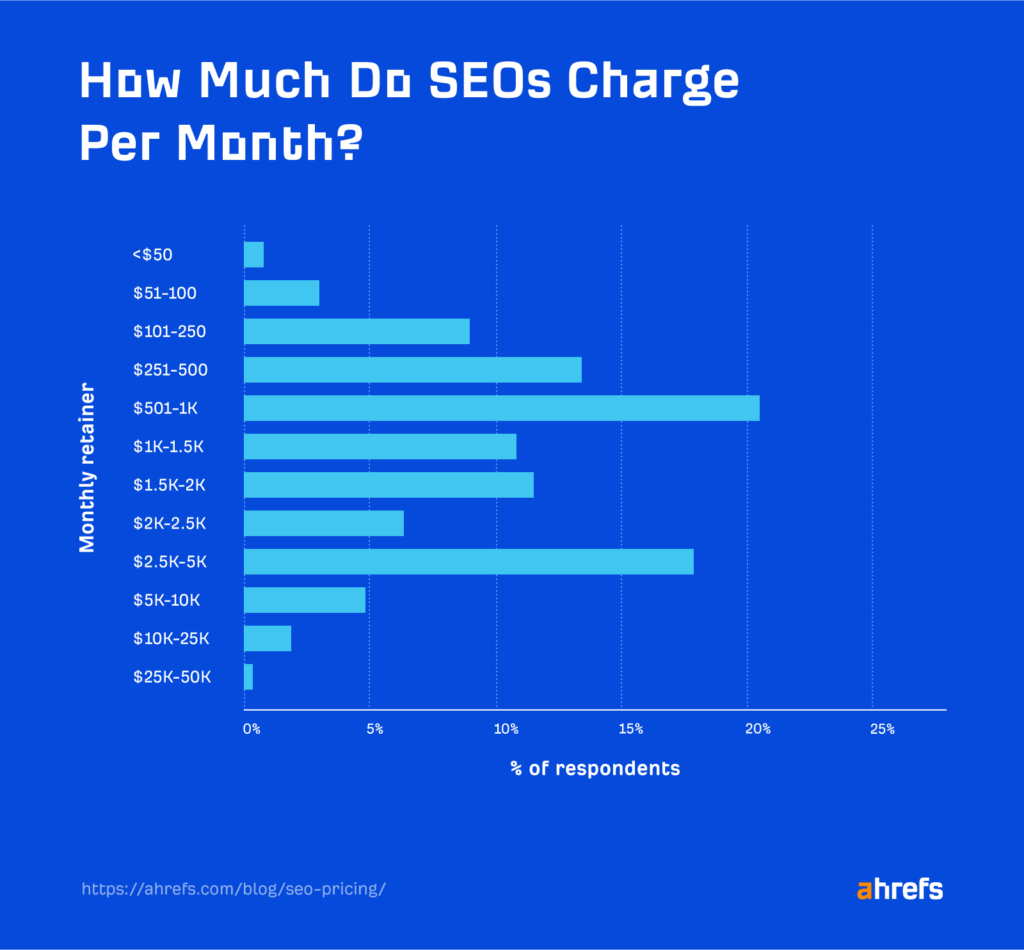
Source: Ahrefs.com
There’s a significant range here.
The chart above shows a range of <$50 – $50,000 per month. Why such a broad range? There are several additional factors that further impact pricing.
- Site size: A site with a million+ URLs will take more time and resources than a site that has 15K pages. This isn’t a per-page fee assessment either. Each page will need attention, but these pages will need to be reorganized, interlinked, optimized, redirected, updated, etc.
- Technology makeup and technical state: This is about the condition of your site. A site that relies heavily on JavaScript for key areas of the site will consume more resources as your team grapples with the challenges this presents. The same applies to technical SEO; if there’s a significant amount of work that needs to be done to bring your site up to speed — (mobile optimization, page speed, security, accessibility, etc.), this will impact pricing.
- Page experience: This is, according to Google, “a set of signals that measure how users perceive the experience of interacting with a web page beyond its pure information value, both on mobile and desktop devices.” It’s a set of metrics (e.g., mobile-friendliness, core web vitals, interactivity, visual stability, etc.) that measure user experience on your web pages.
- Competitor performance: If you’re facing a AAA competitor who’s earned 750 links to earn top-five positions across their keyword portfolio, you’ll have to invest more. Their brand recognition, established rankings, and significant head start will impact the amount you’ll need to invest to surpass them. The same applies to social signals. These aren’t static targets either, as your competitors will continue to improve their position to stay in the lead.
- Indexation and current rankings: If most of the pages on your site are indexed, and you have decent rankings for the majority of the keywords across your portfolio, your campaign will be cheaper, produce results faster, and require fewer resources over time. It’s easier to maintain the results you’ve already achieved than it is to dig yourself out of a hole.
- Publishing cadence: If you’re creating twelve, 1,500-word pieces each week, you’ll see results sooner than a competitor who’s creating three pieces of content per week. You may need to produce a high volume of quality content if your competitors are firmly established. It all depends on your industry and your competitors.
- Promotion resources: Paid search doesn’t increase organic rankings directly; That said, it can and does produce increased links, mentions, coverage, and sharing — all of this leads to increased rankings, traffic, and visibility. Research from Google confirms this; searchers who see ads on specific terms you rank for (i.e., branded keywords) are more likely to click through.
- Language and geography: SEO is automatically more expensive if you’re part of a multi-national conglomerate. You’re going to have to create, index, rank, and maintain content across multiple languages and countries. This isn’t simply a translation issue; in many cases, special considerations will need to be made. Idioms that work in The US won’t land in the UK, France, or South America. Services offered in one country may not be provided in another. Then there’s compliance that’s broken down by industry (i.e., Graham, Leach, Bliley Act), country (i.e., GDPR), or both. This requires careful assessment and management, which increases the price.
In a more recent survey, John Doherty’s team at Credo conducted an SEO pricing survey in 2022 that compared different types of SEO providers. The findings were broken down by function, size, and location of providers:
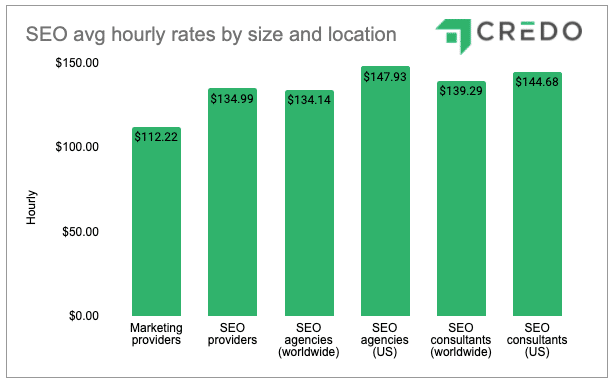
In his analysis, John makes the point that agencies typically undercharge for their services when compared to the long-term compounding business value (well done) SEO provides.
Nevertheless, this is stressful.
So far, we’ve seen more than 18+ factors that can impact the cost of SEO services. This isn’t even a comprehensive list. It doesn’t even take into consideration the must-haves for the SEO agency that you hire.
How are you supposed to get a good read on the cost of SEO?
How to calculate SEO for your company
You focus on your foundation.
What’s the foundation of organic search? It’s:
- Information architecture: How is your data organized? Is it easy for Googlebot to crawl and index? Is it optimized and rendering properly for users regardless of their device, location, time of day, etc. Is it accessible for everyone? Information is oriented around the user experience.
- Content: Does your content satisfy searcher intent throughout the audience/buyer’s journey? Does your content consistently deliver value, or is it simply noise? Your content should match your searcher’s intent, queries, and expectations. Each piece should be up-to-date (a la content equity rebalancing).
- Backlinks: You’re looking for high-quality backlinks with significant domain authority and relevance. These links are harder to come by, but that’s the point. These links dramatically outperform the generic throwaways inexperienced SEOs are over-reliant on.
- Technical SEO: Does your website run fast? Are all of your dev resources optimized? Technical SEO requires you to ensure that everything is running smoothly under the hood. Don’t let your HTML, Javascript, or CMS prevent your site from ranking.
This is the secret.
It’s content, organizing said content, and sharing that content via domains with strong authority. If you begin with these areas, you cover several bases simultaneously. So, let’s take a look at a few formulas you can use to estimate the true cost of SEO.
1. How much for information architecture?
Here’s a general overview of what you’ll need to provide an estimate.
- Content audit (is your content crawlable? Is it indexed and accessible?
- Clear website taxonomy (Is your content organized properly? Is the user experience a consistent and high-quality one across desktop and mobile devices?
- Content engineering plan and content strategy docs
- Technical and nontechnical audits
I’m referring to these deliverables above as “research items.” You may include more research items than the ones I’ve listed above. Be sure to account for these in your estimate.
Then, use the following formula:
(Total People-Hours x Hourly Rate) + (Cost of Goods) * (Agency Markup) = Total Cost of IA
Here’s an example in action.
(75 people-hours x $150 per hr.) + ($5,360) + (30% agency markup) = $21,593 Total Cost of IA
Calculating the rest is easy if you have a rough estimate of the people-hours and the hourly rate.
2. How much for content?
Here’s what we’ll need to know to create an accurate estimate:
- The types of content you’ll offer (e.g., blog posts, whitepapers, quizzes, calculators, infographics, etc.)
- The volume (for each type) per mo. type + volume “Total-Content”
- The average time it takes to produce each type of content (i.e., 4 hours per blog post)
- What it costs (hourly rate) to produce each piece of content
Then, plug these variables into the following formula.
(Total Content x Average Time to Produce) x Average Cost (hourly rate) = Content Production Cost
Here’s an example of a month’s worth of content.
- 2 blog posts (10 hrs per piece), 1 whitepaper (30 hrs per piece)
- Cost: $50 per hour
Let’s plug it into the formula:
(3 pieces x 50 hours) x $50 per hr = $7,500
The formula is the same whether you’re planning on creating a small or large amount of content.
3. How much for high-quality backlinks?
Here’s what we’ll need to know to create an accurate estimate:
- Monthly traffic values* for the top-ranking competitors in your vertical (via Ahrefs or Semrush)
- The number of root domains linking to your competitor
*Note: According to Ahrefs, Paid traffic value shows the estimated monthly cost of paid search traffic from all the keywords that a target website/URL ranks for via PPC
Once you have the data, plug these numbers into the following formula.
Monthly Traffic Values / Linking Root Domains = Dollar Value Per Link
Here’s an example.
4.2M Traffic Value / 1,275 Linking Root Domains = $3,294 Value Per Link
If you’d like to calculate the lifetime value of a link, multiply the Value Per Link by your Average Customer Lifespan. Some recommend a more general figure (i.e., 24 mo.) but using your average customer lifespan will give you a more accurate figure.
These formulas aren’t new.
But they’re helpful tools you can use to establish a firm foundation for SEO services.
What about the other services?
You can use the same formula I used to calculate IA. If you include ancillary services like local search, reputation management, PR, etc., you can use the same formula to create an estimate.
Why the emphasis on an hourly rate?
Wouldn’t project pricing or other pricing models work better? Not so much. Every project has its own set of circumstances. Some sites have a million pages; others have tens of millions of pages. Some domains are action-packed with technical problems that need significant amounts of attention. Other sites are well-maintained and consistent.
You don’t know what you’re dealing with.
Using an hourly rate as the basis for your calculations gives you the flexibility you need to create an accurate plan of attack. This can then be used to negotiate a retainer or project agreement (if needed).
4. How much for Technical SEO?
When it comes to technical SEO, the costs vary significantly. This is tough to assess because the challenges each site faces are unique. What are the top technical challenges each site faces?
- Crawl budget
- Duplicate content
- Site architecture
- Internal linking
- JavaScript errors
- Schema and structured data
- The technical elements of website migration
This is an issue with larger websites as the technical nature of SEO can (and will) make optimization more expensive.
If you’d like to identify the cost of technical SEO you’ll need to assess the following:
- The number of pages
- The extent of the project (e.g., labor intensity, access)
- Cost of goods sold (anything outside of direct labor costs software, licensing, materials, hosting/CDN, bandwidth, compute cycles, etc.)
- Time requirements (e.g., If the client has the budget to overtake a competitor in one year vs. two)
These are issues that would obviously need to be addressed ahead of time.
The cost of SEO seems complicated until it isn’t
What should SEO cost?
We may not have a standard model we can refer to, but we do have the information, structure, and formulas we need to create a solid plan.
When it comes to cost, we have plenty of data we can work with.
Using this data, we can identify competitors we can dethrone. Use this guide to price out your SEO campaigns. When you ask, “Is this a fight we can win? You’ll have a clear answer.
The more informed you are, the more accurate your cost estimation will be.
Interested in learning about the SEO services offered by iPullRank? Reach out via our contact page and let us know what type of project you’re curious about. Your advanced SEO teams can work with us to get some of those dream projects rolling.

